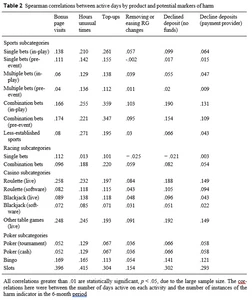The markers of gambling-related harm in poker and beyond

For researchers that study topics related to behavioural psychology and addiction, the data that comes from online gambling is a veritable gold mine of actionable intelligence.
In the days prior to the modernisation of the gambling industry, any analysis of behavioural patterns relied on things like manual data tracking from in-person operators or potentially unreliable surveys from the customers themselves.
The lack of reliable, granular data made it difficult to draw a detailed picture of the connections between a player’s behaviour and their overall exposure to risk.
How data fills in the blanks for safer gambling

Thanks to the richness of digital data, however, researchers today are starting to be able to fill in some of the blanks with empirical evidence.
We’re starting to understand more of the context, the causes and the effects of disordered gambling.
The industry is starting to make and test some data-driven predictions about where players sit on the risk spectrum based on the choices and behaviours they exhibit. We might even be able to get a sense of which games or game formats are inherently riskier than others from a safer-gambling standpoint.
Let’s dig into one recent study that explored the markers of gambling-related harm across various categories using data from a regulated website. There are a few tidbits that might be of interest to poker players, in particular.
Markers of harm for different gambling products
The paper we’re looking at is entitled Behavioural Markers of Harm and Their Potential in Identifying Product Risk in Online Gambling. It was commissioned by Kindred Group in 2022 and it covers a cohort of 100,000 of their UK customers across a period of six months.
The group of researchers included myself, as Kindred’s former head of responsible gambling and now the senior safer gambling consultant for SG:certified.
The purpose of the research was to explore whether certain products are more strongly associated with the established behavioural markers of harm than others. These markers have been uncovered through previous research and include:
– Bonus-seeking behaviour
– Playing at unusual hours
– In-session deposits
– Easing RG settings
– Declined deposits
The analysis was rooted in the broader finding that these markers scale in a predictable way with the total amount of time a customer spends gambling. What the researchers found is that there is a measurable difference in the levels of correlated risk from one category of games to another.
“All markers apart from easing/removing responsible gambling settings appeared to correlate with the number of active days engaging in specific product types, most notably slots, in-playing betting and some most forms of combination bets on sports,” they explained.
“These findings highlight the potential value of using measurable markers to differentiate the risk and potential harm associated with different online products.”
Play mapped to markers of harm
Here’s the table from the paper showing the correlation between active days played and the known markers of harm across the different gambling products analysed:
This dataset helps reinforce some of the perceptions we may already have about the inherent differences in the risk profile of various types of gambling.
It’s easy to grasp why slots, for example, correlate so strongly with harm-based markers considering the pace of the game and the immediacy of the results.
The researchers call this a “short event frequency” and this attribute seems to dovetail with a number of major risk factors. Among the categories studied, slots players produced the highest rates of bonus page visits, RG changes and declined transactions.
What do the authors think?
“The results showed that there were consistently larger associations between various behavioural markers of harm and the number of active days on specific gambling activities,” they concluded.
“Specifically, short event frequencies (such as slots and in-play betting), betting on different permutations of more than one bet selection in a single transaction (for example, combination bets) and, contrary to our expectations, engaging in live rather than simulated table games play were the three structural configurations of products which appeared more strongly associated with patterns of riskier play.”
The full paper on product risk is available through the International Journal of Mental Health and Addiction.
Where does poker fall on the risk spectrum?
With a mean correlation of 0.07 across all markers of harm, poker ranks near the bottom of the list.
Poker players do not exhibit especially high levels of bonus-seeking behaviour, they infrequently top-up during a session and they experience fewer declined transactions than most other gamblers.

At first glance, the research seems to frame poker as a comparatively low-risk game. Mean correlations for both tournaments and cash games indicate that players who play more often are not necessarily exposing themselves to proportionally more risk.
When played online in particular, the game does not meet any of the three highest-risk criteria identified by the researchers. It has a long event frequency, a relatively concise betting structure and is entirely simulated by software.
But is that the whole story?
What’s missing in the data, however, is a consideration of the intangible characteristics that set poker apart from most forms of gambling – most notably the element of skill.
In broad terms, research is not yet conclusive on how the role of skill in a particular game affects its correlation to these risk markers. And it may seem logical that the presence of skill would naturally mitigate some of the exposure to gambling-related harm.
If we look harder, however, we can start to spot some ways in which skill-dependent games like poker could expose a player to a unique set of risks related to time management.
Preoccupation and poker
Poker demands so much more time than the other games you’ll find in a casino and that’s the start of any discussion about its associated risks. It is an all-consuming game in ways that most forms of gambling are not and becoming a successful player fundamentally requires a substantial investment of time.
That leads to the complementary issue of potential preoccupation.
Slots players, as a contrary example, aren’t typically preoccupied with the games they play. Once you walk away from the slot machine, you’re probably done thinking about it.
But poker has a way of sticking with you after you leave the table, partially because of that element of skill. The fact that your results depend on your skill to a significant extent provides a built-in incentive to invest more of your time and energy into mastering it.

You might therefore spend your free time reading poker books or consuming poker content to try to boost your overall level of skill. Your friends probably play poker too and you likely spend a considerable amount of conversation talking through hands with them. There aren’t many decisions to analyse after you leave the roulette wheel, but poker players live in constant pursuit of perfection.
We can see some evidence of this preoccupation in another section of the paper that analysed activity rates. A full 18% of the online poker population was found to play on a weekly basis, nearly double the percentage of the next-largest cohort (slots). The average online poker player plays approximately 33 days out of every year too, almost twice as frequently as any other category of gambler. Slots players by comparison average about 17 days of activity per year.
Beware of the Tetris effect
It’s all too easy for poker to cross the line from hobby (or job) to a dangerous preoccupation. And it’s certainly not unique as a threat in this regard. Video games, social media, television drama, secular jobs – all of these things have the potential to occupy too much of our brains through periods in which we should be tending to other responsibilities.
Behavioural researchers already have a term for this sort of unconscious preoccupation: The Tetris Effect.
As early video games like Tetris began to become a part of pop culture in the late 1900s, some players began to experience the sounds and visuals of the game in their subconscious thoughts and dreams. For a cohort of Tetris players, the game became a preoccupation. Even when they weren’t playing it with their hands, they were playing it in their heads.

The point at which this preoccupation becomes dangerous in a game like Tetris or poker is hard to define and it’s indeterminable using the established time-based markers of harm in gambling.
It’s also hard to spot in poker in particular, because the element of skill and the other fundamental qualities of the game tend to excuse some of the time commitment as the mere pursuit of perfection.
Maintaining a healthy balance in poker play
If you played slots from sundown to sunrise, for example, your friends would probably start to get worried about you. That sort of behaviour would be a fairly obvious cause for concern. But in online poker, playing long or odd hours is not necessarily an indication of increased risk.
Maybe the game is running in a different time zone, or maybe it’s a big tournament day, or maybe you’re just leveraging the pensive nature of the game itself.
That said, it is worthwhile to pay attention to your habits in this regard. The data seems to show that most poker players don’t let the game deplete their finances. But beware of the hidden dangers that arise when poker begins to consume your everyday thoughts and behaviours.
Being cognisant of the risk factors associated with your non-financial resources can help you maintain a healthy balance between the time and energy you spend playing poker and the effort you put into betting yourself away from the tables.
Making markers into mileposts
SG:certified is one of the groups leading the effort to put real regulatory action behind this type of research into gambling behaviour. After all, what good is new insight if we don’t use it to implement some responsive practices? And what’s the use of making rules if they’re not enforced?
Think about traffic laws as a parallel. Most drivers can appreciate the correlation between excessive speed and traffic accidents and decades of transportation research has led most governments to impose speed limits for their public roads. It’s the only reasonable response to the data.
These restrictions not only serve to make the public aware of the safe limits, they also provide a defined threshold for enforcement.
Merely identifying the safe speed for a given road isn’t enough to protect drivers. Making the roadways safer requires monitoring and enforcement. It requires speed checks and the issuance of citations for those who violate the posted limits. Rules need to have consequences in order to matter.
Gambling regulation is not so different from traffic management. The rules designed to make gambling safer are rooted in empirical evidence and their main purpose isn’t to dole out punishments. Regulations, like speed limits, primarily exist to protect the public.

Catania and SG:certified operate in that overlap between safer-gambling research and policy, leveraging their bespoke compliance dashboard to help stakeholders collaborate on strategies for building products and processes that truly protect consumers – particularly those at high risk. In this way, the gambling industry can begin to mark its progress toward a safer future.
If you’re an operator or a regulator keen on keeping your product up to speed with the most-current behavioural research in gambling, SG:certified is eager to show you the path forward. You can schedule a free demo with their team here.

